Introduction
Diodes are fundamental building blocks in the world of electronics, playing a critical role in countless devices and circuits. As of June 27, 2025, with technology advancing at a rapid pace, understanding the various types of diodes, their symbols, and their applications is more important than ever for hobbyists, students, and professional engineers. This article guide dives deep into the world of diodes, offering a detailed exploration of their functionality, design considerations, and practical uses. Whether you’re designing a power supply, experimenting with LEDs, or working on advanced semiconductor projects, this article will equip you with the knowledge to succeed. Let’s illuminate the essentials of diodes!
What Are Diodes?
A diode is a two-terminal electronic component that allows current to flow in one direction while blocking it in the opposite direction. This unidirectional behavior stems from its semiconductor construction, typically made from materials like silicon or germanium. Diodes are essential for tasks such as rectification, voltage regulation, signal modulation, and light emission, making them indispensable in modern electronics.
The evolution of diode technology has been remarkable. From the early vacuum tube diodes to today’s advanced semiconductor versions, diodes have become smaller, more efficient, and versatile. In 2025, with the rise of IoT devices, renewable energy systems, and high-speed communication networks, diodes continue to adapt, incorporating new materials and designs to meet emerging demands.
The Basics of Diode Operation
Diodes operate based on the principle of the p-n junction, where p-type (positive) and n-type (negative) semiconductors meet. When forward-biased (positive voltage applied to the anode), the diode conducts current with a small voltage drop (typically 0.7V for silicon diodes). When reverse-biased, it blocks current, acting as an insulator—up to its breakdown voltage.
This behavior is governed by the diode’s I-V (current-voltage) characteristic curve, which shows a sharp increase in current with minimal voltage increase in the forward direction and a near-zero current in reverse bias. Understanding this curve is crucial for selecting the right diode for a specific application, a topic we’ll explore further.
Types of Diodes and Their Symbols
Diodes come in various forms, each with a unique symbol that reflects its function. The image provided offers a visual guide to eight common types, which we’ll analyze in detail:
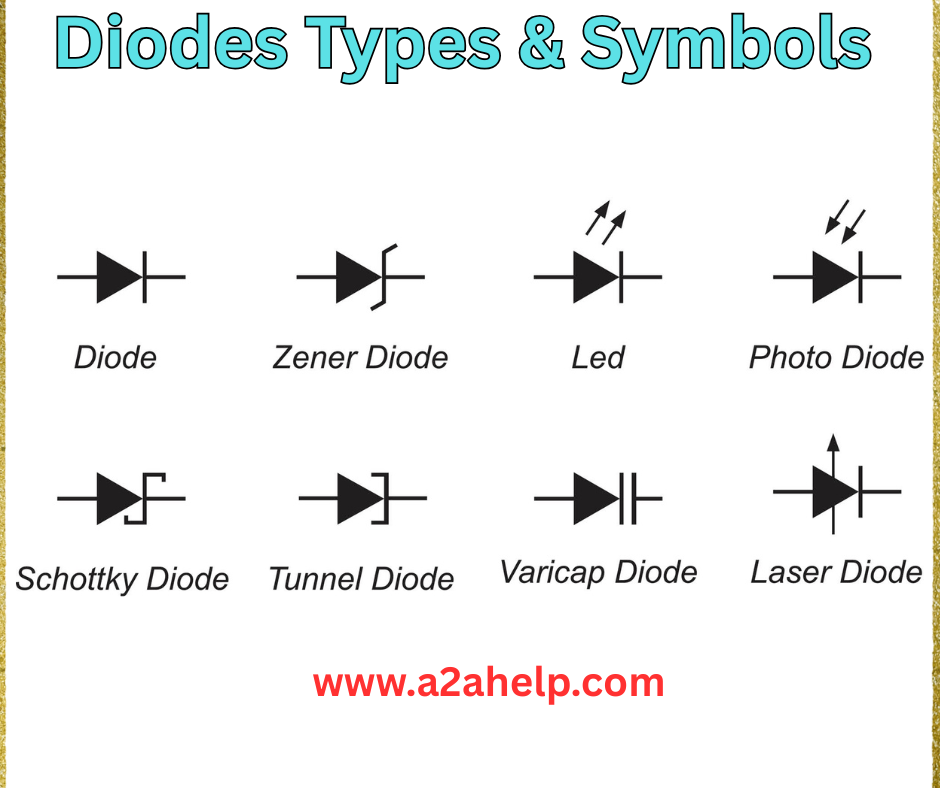
1. Standard Diode
The standard diode symbol (a triangle pointing to a line) represents a basic rectifier diode. It’s used to convert alternating current (AC) to direct current (DC) in power supplies. Common examples include the 1N4007, widely used for general-purpose rectification.
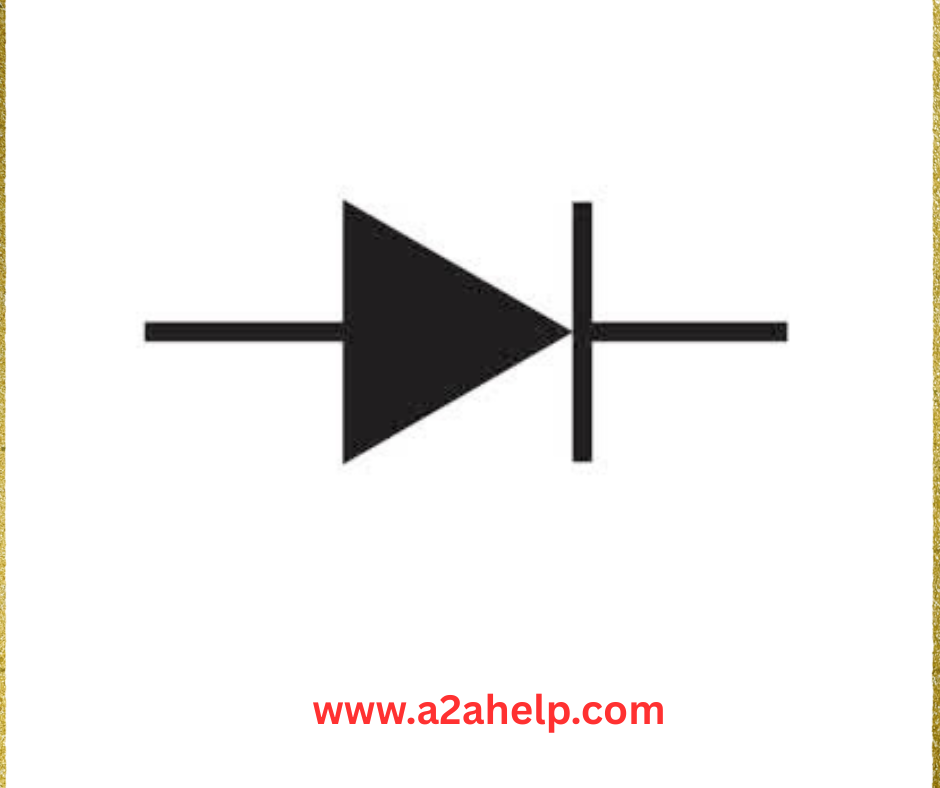
2. Zener Diode
Featuring a bent line at the cathode, the Zener diode symbol indicates a diode designed to operate in reverse breakdown mode. This allows it to maintain a constant voltage across its terminals, making it ideal for voltage regulation. The 1N4733A (5.1V Zener) is a popular choice.
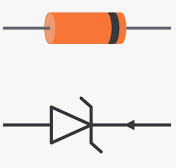
3. LED (Light Emitting Diode)
With arrows pointing outward, this symbol denotes a diode that emits light when forward-biased. LEDs are ubiquitous in lighting, displays, and indicators, with modern variants like the OSRAM OSLON offering high efficiency.
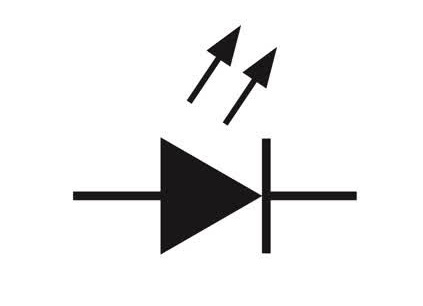
4. Photo Diode
Arrows pointing inward signify a diode that generates current when exposed to light. Used in light sensors and solar cells, the BPW34 is a common photo diode known for its sensitivity.
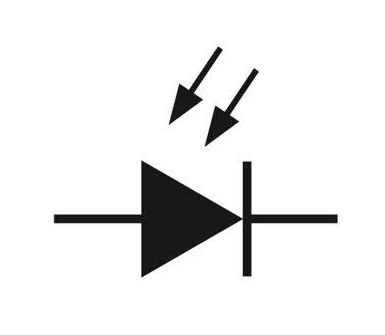
5. Schottky Diode
The “S” shape in the symbol indicates a fast-switching diode with a low forward voltage drop (around 0.2-0.3V). The 1N5819 is a typical Schottky diode, often found in switch-mode power supplies.
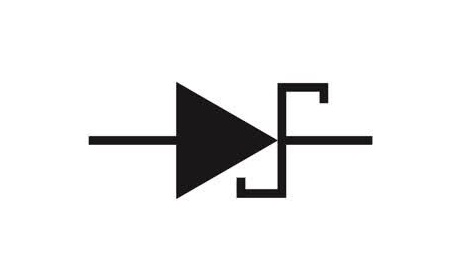
6. Tunnel Diode
Similar to a Zener but with a distinct bent line, this symbol represents a diode with negative resistance, used in high-frequency oscillators. The 1N3716 is an example, though less common today.
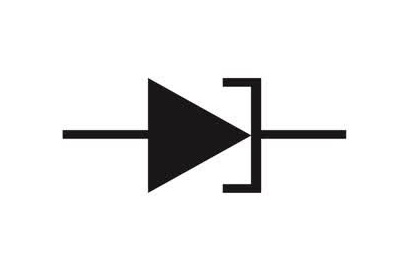
7. Varicap Diode
Two parallel lines at the cathode indicate a diode whose capacitance varies with applied voltage, useful in tuning circuits. The BB135 is a widely used varicap in RF applications.
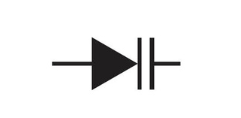
8. Laser Diode
Arrows showing light emission denote a diode that produces coherent light. Found in laser pointers and optical communication, the HL63193MG is a modern laser diode example.
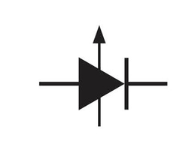
Detailed Analysis of Diode Types
1. Standard Diode
Standard diodes, like the 1N4007, are the workhorses of rectification. They handle currents up to 1A and voltages up to 1000V, making them suitable for basic power supplies. Their simplicity and low cost ensure widespread use, though they’re slower than Schottky diodes due to higher switching times.
2. Zener Diode
Zener diodes excel in voltage regulation. By operating in the reverse breakdown region, they maintain a stable output voltage. For instance, a 5.1V Zener can regulate a fluctuating input to a steady 5.1V, critical for protecting sensitive electronics. Selection depends on power dissipation and temperature stability.
3. LED
LEDs have revolutionized lighting with their energy efficiency. A typical white LED might emit 100 lumens per watt, far surpassing incandescent bulbs. In 2025, advancements in organic LEDs (OLEDs) and micro-LEDs are pushing boundaries in display technology, offering brighter and more flexible options.
4. Photo Diode
Photo diodes convert light into electrical current, with applications in photography, solar energy, and optical communication. Their sensitivity to specific wavelengths makes them ideal for precise measurements, though they require careful calibration to avoid noise.
5. Schottky Diode
Schottky diodes’ low forward voltage and fast switching (nanoseconds) make them perfect for high-frequency circuits and solar inverters. Their metal-semiconductor junction reduces power loss, a key advantage in energy-efficient designs.
6. Tunnel Diode
Tunnel diodes, with their negative resistance, were pioneers in microwave technology. Though less common today due to alternatives like Gunn diodes, they remain relevant in niche high-speed applications, offering unique oscillation properties.
7. Varicap Diode
Varicap diodes, also called varactors, adjust capacitance with voltage, enabling fine-tuning in radios and TVs. Their non-linear response requires careful circuit design, but they offer compact solutions for frequency modulation.
8. Laser Diode
Laser diodes produce coherent light, essential for fiber optics and medical devices. With wavelengths ranging from 405nm (blue) to 1550nm (infrared), they’re tailored for specific uses, though they demand precise current control to avoid damage.
Applications of Diodes in 2025
Diodes are integral to modern technology. Here are some key applications:
- Power Supplies: Standard and Zener diodes rectify and regulate voltage in adapters and chargers.
- Lighting: LEDs dominate residential and automotive lighting, with smart LEDs integrating IoT features.
- Sensors: Photo diodes power security systems and environmental monitors.
- Communication: Schottky and laser diodes enhance high-speed data transmission in 5G and fiber optics.
- RF Circuits: Varicap diodes tune frequencies in wireless devices.
How to Select the Right Diode
Choosing a diode involves considering several factors:
- Voltage Rating: Ensure the peak inverse voltage (PIV) exceeds the circuit’s maximum reverse voltage.
- Current Capacity: Match the forward current (IF) to the load requirements.
- Switching Speed: Opt for Schottky or fast-recovery diodes for high-frequency applications.
- Temperature Range: Verify the diode’s operating temperature aligns with environmental conditions.
For example, a power supply might use a 1N4007 for low-speed rectification, while a solar inverter might require a 1N5819 for efficiency.
Diode Installation and Safety
Proper installation prevents failures. Always observe polarity—connect the anode to the positive side and cathode to the negative. Use heat sinks for high-power diodes like Zeners or lasers to dissipate heat. Test with a multimeter in diode mode to confirm functionality, checking for a voltage drop of 0.6-0.7V in forward bias.
Safety is paramount. Avoid exceeding the diode’s ratings to prevent thermal runaway or explosion. Wear protective gear when handling high-voltage circuits.
Troubleshooting Common Diode Issues
- No Current Flow: Indicates reverse polarity or a blown diode. Replace and retest.
- Overheating: Suggests excessive current or poor heat dissipation. Check ratings and add a heat sink.
- Intermittent Operation: May point to a loose connection or degraded junction. Resolder or replace.
The Future of Diodes in Electronics
In 2025, diode technology is evolving with innovations like gallium nitride (GaN) diodes, offering higher efficiency and power density for electric vehicles and renewable energy. Quantum dot LEDs promise brighter displays, while silicon carbide (SiC) Schottky diodes enhance power electronics. These advancements reflect a shift toward sustainability and performance, aligning with global tech trends.
Conclusion
Diodes are the unsung heroes of electronics, enabling everything from power management to cutting-edge communication. By understanding their types, symbols, and applications, you can harness their potential in your projects. Whether you’re building a simple LED circuit or a complex laser system, this guide provides the foundation to succeed. For more electronics insights and schematics, visit www.a2ahelp.com. Start experimenting with diodes today and light up your electronic journey!
